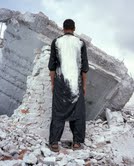Lida Abdul – What we have overlooked

La grande parete dello spazio di Via Principessa Clotilde ospita l’opera a due canali di Lida Abdul What We Have Overlooked (2011), presentata a dOCUMENTA (13).
Comunicato stampa
lida abdul
what we have overlooked
20 giugno | 14 settembre 2013
La grande parete dello spazio di Via Principessa Clotilde ospita l’opera a due canali di Lida Abdul What We Have Overlooked (2011), presentata a dOCUMENTA (13).
Il video, girato presso un lago vicino a Kabul, vede un uomo immergersi progressivamente nell’acqua, reggendo una bandiera. In un alternarsi di immagini di prossimità e di distanza, seguiamo l’azione del protagonista, al quale i sottotitoli danno voce, fino a quando questi non viene completamente sommerso.
Lo scollamento tra il paesaggio idilliaco e il dolore dell’uomo (we do not want to become legendary because we’ll disappear / we seek to cleanse ourselves from the illusions of certainties / we are tired of remembering so much), evidenzia quanto l’opera si muova tra contrasti, anche formali: pur avendo come referente la cultura occidentale, l’artista attinge ad un bagaglio tradizionale e iconografico tratto dall’Islam, Buddismo e Induismo, dei quali, a sua volta, la cultura afghana è debitrice. La raffinatezza esteriore si trova dunque a stridere con il disastro contemporaneo, sempre presente nei lavori dell’artista e qui calato in una cornice perfetta e immobile, un lago celeste su cui si specchiano montagne imbiancate.
Nel video, in particolare, Lida Abdul esamina la relazione che intercorre tra l’individuo e la nazione, rappresentata dalla bandiera, suo simbolo astratto (it holds you without holding you). Il rapporto quasi dialettico stretto tra l’uomo e il suo paese - che non solo ne sovradetermina la presenza, ma può arrivare addirittura ad esigerne il sacrificio - porta infine l’artista a constatare il prezzo drammaticamente alto che il sentimento nazionalista è pronto a pagare: l’annullamento dello stesso individuo.
Lida Abdul - Kabul, 1973.
Nata in Afghanistan pochi anni prima dell’invasione sovietica, vive e lavora tra Los Angeles e Kabul.
Prima artista del suo paese a rappresentare l’Afghanistan alla 51esima edizione della Biennale di Venezia nel 2005, è stata quindi selezionata per partecipare a numerose Biennali: São Paulo Biennial 2006; Gwangju Biennial 2006; Moscow Biennial 2007; Sharjah Biennial 2007; Göteborg Biennial 2007. La sua opera è inoltre stata presentata a: Istanbul Modern; Kunsthalle Vienna; Museum of Modern Art Arnhem, Netherlands; Miami Central; ICA Toronto; ZKM Karlsruhe; Capc Bordeaux; CAC Centre d’Art Contemporain de Brétigny; Frac Lorraine, Metz; Musée Chagall, Nice; Tate Modern, London; MOMA, New York; Location One, New York; OK Centrum for Contemporary Art, Linz; Western Front Exhibitions, Vancouver; Centre A, Vancouver; Indianapolis Museum of Art; Royal Academy of Arts, London; The Andy Warhol Museum, Pittsburgh; Zentrum Paul Klee, Berne; Museum on the Seam, Jerusalem; Louis Vuitton Espace, Paris; Palais de Tokyo, Paris; dOCUMENTA (13), Kassel; Fundação Calouste Gulbenkian, Lisbon. Ha vinto il Taiwan Award (2005), il Premio Pino Pascali e il Prince Claus Award (2006) e l’UNESCO Prize for the Promotion of the Arts (2007). Il suo lavoro compare in numerose collezioni private e pubbliche, tra le quali quella del Frac Lorraine, della GAM di Torino, della Fondation Louis Vuitton, Parigi e del MOMA, New York.
The large wall of the gallery’s space in Via Principessa Clotilde will host the two-channel work by Lida Abdul entitled “What we have overlooked” (2011), presented at dOCUMENTA (13), Kassel.
The video, filmed by a lake near Kabul, shows a man progressively slipping underwater whilst holding a flag. In an alternation of close-up and distant views, we follow the actions of the man to whom the subtitles give a voice, until he finally vanishes under the surface.
The sharp difference between the idyllic landscape and the man’s suffering (we do not want to become legendary because we’ll disappear / we seek to cleanse ourselves from the illusions of certainties / we are tired of remembering so much), stresses to what extent the work develops between contrasts, including some formal ones: despite having Western culture as its point of reference, the artist draws also on a traditional and iconographic baggage based on Islam, Buddhism and Hinduism, to which, in turn, Afghan culture owes much. The outer refinement thus clashes with the contemporary disaster that is always present in the artist’s works and is here dropped within a perfect, immobile frame, a blue lake in which are reflected some snow-clad mountains.
In particular, in the video, Lida Abdul examines the relationship between individual and nation, represented by the flag, its abstract symbol (it holds you without holding you). The almost dialectical relationship created between a man and his country – which not only over-determines his presence but can even demand the sacrifice of his life – finally leads the artist to make clear the dramatically high price the nationalist feeling is prepared to pay: the annulment of the individual.
Lida Abdul - Kabul, 1973.
Born in Afghanistan a few years before the Soviet invasion, she lives and works in Los Angeles and Kabul.
The first artist of her country to represent Afghanistan at the 51st edition of the Venice Biennale in 2005, she was then selected to participate in numerous other Biennales: São Paulo Biennial 2006; Gwangju Biennial 2006; Moscow Biennial 2007; Sharjah Biennial 2007; Göteborg Biennial 2007. Her work has also been presented at: Istanbul Modern; Kunsthalle Vienna; Museum of Modern Art Arnhem, Netherlands; Miami Central; ICA Toronto; ZKM Karlsruhe; Capc Bordeaux; CAC Centre d’Art Contemporain de Brétigny; Frac Lorraine, Metz; Musée Chagall, Nice; Tate Modern, London; MOMA, New York; Location One, New York; OK Centrum for Contemporary Art, Linz; Western Front Exhibitions, Vancouver; Centre A, Vancouver; Indianapolis Museum of Art; Royal Academy of Arts, London; The Andy Warhol Museum, Pittsburgh; Zentrum Paul Klee, Berne; Museum on the Seam, Jerusalem; Louis Vuitton Espace, Paris; Palais de Tokyo, Paris; dOCUMENTA (13), Kassel; Fundação Calouste Gulbenkian, Lisbon. She has won the Taiwan Award (2005), the Premio Pino Pascali and the Prince Claus Award (2006), as well as the UNESCO Prize for the Promotion of the Arts (2007). Her work appears in numerous public and private collections, including the Frac Lorraine, GAM, Torino, the Fondation Louis Vuitton, Paris and the MOMA, New York.



